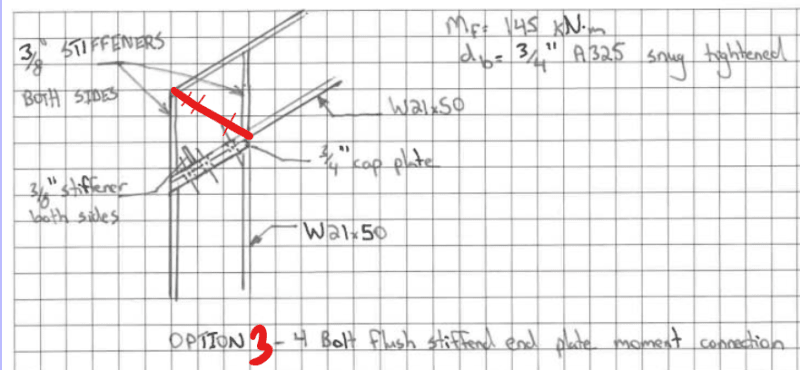Hi All,
Currently exploring different options with the architect for the eaves connections in an exposed steel portal frame. The roof angle is relatively high (about 33 degrees to the horizontal) so the roof angle needs to be followed all the way to the far flange of the column (as opposed to having a flat top at the column). In the image below I show the two preferred options from the architect.
In option 1, there has been discussion of the bolt in peak tension being relatively close to the end of the beam. I don't see this being an issue from a strength perspective, only a bolt access perspective. The fabricator also prefers option 1 since there are fewer cuts to the beam end. My only qualm with option 1 is that it requires a stiffener due to the relatively thin flange. From a strength perspective, can anyone come up with arguments for one option over the other? Would you agree that the gravity load of the beam will be adding an unwanted lateral component to the column in Option 1 since the connection plate is not level?

Thank you in advance
Currently exploring different options with the architect for the eaves connections in an exposed steel portal frame. The roof angle is relatively high (about 33 degrees to the horizontal) so the roof angle needs to be followed all the way to the far flange of the column (as opposed to having a flat top at the column). In the image below I show the two preferred options from the architect.
In option 1, there has been discussion of the bolt in peak tension being relatively close to the end of the beam. I don't see this being an issue from a strength perspective, only a bolt access perspective. The fabricator also prefers option 1 since there are fewer cuts to the beam end. My only qualm with option 1 is that it requires a stiffener due to the relatively thin flange. From a strength perspective, can anyone come up with arguments for one option over the other? Would you agree that the gravity load of the beam will be adding an unwanted lateral component to the column in Option 1 since the connection plate is not level?

Thank you in advance



